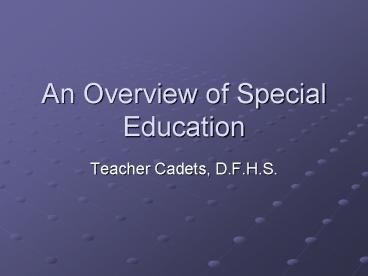An Overview of Special Education - PowerPoint PPT Presentation
1 / 19
Title:
An Overview of Special Education
Description:
An Overview of Special Education Teacher Cadets, D.F.H.S. What is Special Education? Special Education is the educational program designed to meet the unique learning ... – PowerPoint PPT presentation
Number of Views:333
Avg rating:3.0/5.0
Title: An Overview of Special Education
1
An Overview of Special Education
- Teacher Cadets, D.F.H.S.
2
What is Special Education?
- Special Education is the educational program
designed to meet the unique learning and
developmental needs of an exceptional student. - It recognizes the unique nature of each
individual student. - It is planned specifically to address areas of
need for the student with disabilities. - What areas of need might Special Education
programs address? - What similarities/differences do you see between
Special Education and General Education?
3
People First Language
- Speak of the person first, then the disability.
- Emphasize abilities.
- Dont label people as part of a disability group
(i.e., BD kids) - Why have terms used to describe individuals with
disabilities changed over the years?
4
Normalization, Deinstitutionalization, Inclusion
- Wolfsenberger individuals with disabilities
should have opportunities to live a normal
life. - How do we see this principle at work today?
- What is inclusion?
5
Best Practices for Inclusion
- Three assumptions
- Adequate teacher preparation
- Students with disabilities are productive
learners - Students and teachers are provided with adequate
supports - QUESTIONS?
6
Federal Laws
- Section 504 of the Rehabilitation Act, 1973
- PL 94-142 Individuals with Disabilities Act
(EHA), 1975 - PL 101-476 Individuals with Disabilities
Education (IDEA),1990 - Americans with Disabilities Act (ADA),1990
- PL 105-17 IDEA,1997
- PL 107-110 No Child Left Behind Act (NCLB) of
2001 - What law has had the most profound impact on how
students with disabilities receive services?
Why?
7
IDEA Categories of Disability
- Autism
- Deaf-Blindness
- Deafness
- Emotional Disturbance
- Hearing Impaired
- Mental Retardation
- Multiple Disabilities
- Other Health Impaired
- Orthopedic Impairments
- Speech or Language Impairment
- Specific Learning Disability
- Traumatic Brain Injury
- Visual Impairment
- Is it necessary to use categories to label
individuals with disabilities? Why or why not?
8
Key Components of IDEA
- Zero Reject
- Free Appropriate Public Education (FAPE)
- Least Restrictive Environment (LRE)
- Nondiscriminatory Evaluation
- Due Process and procedural safeguards
- Technology-related Assistance Related Services
- Parental Involvement
- What do you think is the most critical component
of IDEA? Why?
9
Educational Programs
- Individualized Family Service Plan (IFSP)
- Individualized Transition Plan (ITP)
- Individualized Education Plan (IEP)
- 504/Accommodation Plan
- What is the difference in these plans?
10
Service Delivery
- Regular classroom with no supports
- Inclusion with supports
- Full inclusion or pull-in programming
- Team teaching
- Co-teaching
- Consultation/collaborative teaching
- Resource room (up to 3 hours per day)
- Self-contained special education class (most or
all of ones day) - Separate day school
- Residential setting
11
Learning Environments for Exceptional Children
12
Placements (1997-98)
13
Individualized Education Programs
- Required by PL 94-142 (IDEA) and require plans
for transition services by age 16 for all
students - Specifies plans for services, placement,
transitional planning, and other assurances - Designed after careful examination and assessment
by a number of multidisciplinary specialists
14
Purposes of IEPs
- Instructional directionRemedy to the Cookbook
approach - Form the basis for evaluationlearning objectives
determine effectiveness and efficiency of
instruction - Improved communicationfacilitate interaction and
reference between school staff, teachers,
parents, and students
15
IEP team members
- Parents of the student
- Special education teacher
- General education teacher
- Local education agency representative
- Person to interpret evaluation results
- Student (when appropriate)
- Other persons invited by parents or school
16
IEP components
- Frequency, location, and duration of services
- How progress to annual goals will be measured
- Procedures for informing parents of progress
- Transition services (age 14)
- Transfer of rights before reaching age of majority
- Present Level of Performance (PLOP)
- Annual goals/short-term objectives
- Related services
- Program modifications or supports
- Modifications to assessment
- Start date for services
17
PLOP and Annual goals
- PLOP Provides basis for subsequent goal setting
- Should be viewed as summaries of strengths and
weaknesses - Can take a variety of forms
- Annual Goals predict long-term goals that can
be evaluated clearly - Make the IEP measurable
- Common features?
- Should be positive, precise, and relevant to
student needs
18
Short Term Objectives (STO)
- Serve as stepping stones toward annual goals
- Specific representations of the skills to be
learned - Should be specific, observable, measurable,
student-oriented, and positive - Must reflect major instructional achievements
between current performance level and ultimate
goal - Typically 38 objectives per IEP
19
504 or Accommodation Plans
- Accommodation plans are a direct result of
Section 504 of the Vocational Rehabilitation Act - Students must have an impairment that
significantly limits one major life activity - Walking
- Seeing
- Hearing
- Speaking
- Breathing
- Learning
- Working
- Caring for oneself
- The school must provide reasonable
accommodations comparable to those provided to
their peers.































